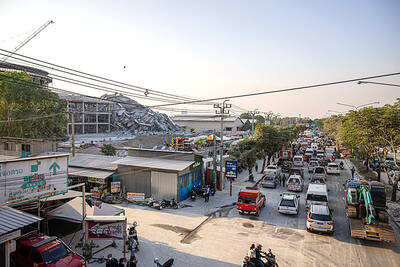Representatives of the self-help organization of Siaolin Village (小林), Kaohsiung County, that was wiped out by Typhoon Morakot in August, leaving nearly 500 people buried by massive landslides, yesterday called for a debate with the government over the causes of the disaster.
The demand came after the release of an official report by the Public Construction Commission (PCC) on Monday that blamed the tragedy on record rainfall and not a water diversion project many typhoon survivors considered the main reason.
“We have substantial evidence to challenge the findings and do not fear a debate. The report was fraught with errors. If our request is denied, we will see them in court,” Lu Tai-ying (魯台營) told the Taipei Times by telephone.
Lu said that while the report claimed the main cause of the mudslide was the 1,856mm of rain that fell within 72 hours in Siaolin, the village was flattened 48 hours after the rain began.
“When the mudslide occurred, the accumulated rainfall was between 1,400mm and 1,500mm. If the report was right about the critical value of precipitation, which it said was 1,700mm, rainfall should be one of the causes, but not the main cause,” Lu said.
Lu also questioned the adequacy of the rationale used to rule out the possibility of the trans-basin water diversion tunnel project, designed to channel water from the Laonong River (荖濃溪) to the Zengwun Reservoir (曾文水庫), as the prime cause of the mudslide.
At a press conference held yesterday morning to present the report, Shannon Lee (李咸亨), spokesman of the team in charge of the report, likened the impact on the local geology caused by the tunnel’s drill and blast construction method to hits by a mosquito.
”I really wanted to find evidence that supports the claim [that the tunnel project was behind the mudslide], but I couldn’t,” Lee said.
Lee said the tremors caused by the construction of the tunnel did not exceed the threshold that would lead to the disaster.
He said the conclusion was partly drawn from the fact that the non-conformance rate of tremors caused by the construction work during the period between 2006 and 2008 was less than the normal environment background level recorded between 2004 and 2006, according to the data kept by the Environment Protection Administration.
The construction began on Dec. 20, 2006.
Lee said the report’s conclusion was also based on the fact that the amount of explosives used to blast the tunnel was insufficient to have caused tremors large enough to lead to disaster.
The largest amount of explosives used at any one time was 182kg, less than the tremor caused by the 2006 Hengchun Earthquake, the equivalent of 475 million kilograms of explosives.
“I was also challenged by people who said that even small tremors could cause disasters when they are repeated,” Lee said.
“My answer was: ‘The tremor caused by the drill-and-blast method was like the energy released by a firework. Even if a firework is ignited 100 times, the energy still cannot be compared to the energy that is released by an earthquake,’” Lee said.
“If a person is hit by a mosquito several hundred times, it can’t be compared to being run over by a tank,” he said.
Lu, however, said that the report did not give direct evidence to prove that the impact of the water diversion project was negligible.
“What basis do they have to claim that the project was unrelated? The [stated-owned] Central Geological Survey recently found that the tunnel was constructed across a fault called the Nei-ying Fault [內英斷層]. The report didn’t even mention that,” Lu said.
Given the fact that the country had never completed a thorough survey into its geology and had a very limited understanding, “why did they jump to such a conclusion?” Lu said.
Later yesterday, Lee said by telephone that while he agreed with Lu about the “lack of a detailed understanding of the sensitivity of geology,” the conclusions reached by his team remained valid.
“In theory, it is possible that a tunnel construction project could cause a mudslide ... but in this case, it was an extremely low likelihood,” Lee said.
Lee said he regretted that a plan, suggested by Wulf Schubert, an Austrian expert, to use the drill-and-blast method to construct an experimental tunnel at 16 sites to test the impact of such a project on the environment was called off due to opposition by residents.
PCC chairman Frank Fan (范良銹) said the commission would refer the report to the Executive Yuan, which will decide whether to resume the suspended water diversion project.
The research team was formed by members of the Chinese Institute of Civil and Hydraulic Engineering (CICHE) and led by Chen Ching-chun (陳清泉), a professor at the Department of Civil Engineering at National Taiwan University.

AIR SUPPORT: The Ministry of National Defense thanked the US for the delivery, adding that it was an indicator of the White House’s commitment to the Taiwan Relations Act Deputy Minister of National Defense Po Horng-huei (柏鴻輝) and Representative to the US Alexander Yui on Friday attended a delivery ceremony for the first of Taiwan’s long-awaited 66 F-16C/D Block 70 jets at a Lockheed Martin Corp factory in Greenville, South Carolina. “We are so proud to be the global home of the F-16 and to support Taiwan’s air defense capabilities,” US Representative William Timmons wrote on X, alongside a photograph of Taiwanese and US officials at the event. The F-16C/D Block 70 jets Taiwan ordered have the same capabilities as aircraft that had been upgraded to F-16Vs. The batch of Lockheed Martin

GRIDLOCK: The National Fire Agency’s Special Search and Rescue team is on standby to travel to the countries to help out with the rescue effort A powerful earthquake rocked Myanmar and neighboring Thailand yesterday, killing at least three people in Bangkok and burying dozens when a high-rise building under construction collapsed. Footage shared on social media from Myanmar’s second-largest city showed widespread destruction, raising fears that many were trapped under the rubble or killed. The magnitude 7.7 earthquake, with an epicenter near Mandalay in Myanmar, struck at midday and was followed by a strong magnitude 6.4 aftershock. The extent of death, injury and destruction — especially in Myanmar, which is embroiled in a civil war and where information is tightly controlled at the best of times —

China's military today said it began joint army, navy and rocket force exercises around Taiwan to "serve as a stern warning and powerful deterrent against Taiwanese independence," calling President William Lai (賴清德) a "parasite." The exercises come after Lai called Beijing a "foreign hostile force" last month. More than 10 Chinese military ships approached close to Taiwan's 24 nautical mile (44.4km) contiguous zone this morning and Taiwan sent its own warships to respond, two senior Taiwanese officials said. Taiwan has not yet detected any live fire by the Chinese military so far, one of the officials said. The drills took place after US Secretary

THUGGISH BEHAVIOR: Encouraging people to report independence supporters is another intimidation tactic that threatens cross-strait peace, the state department said China setting up an online system for reporting “Taiwanese independence” advocates is an “irresponsible and reprehensible” act, a US government spokesperson said on Friday. “China’s call for private individuals to report on alleged ‘persecution or suppression’ by supposed ‘Taiwan independence henchmen and accomplices’ is irresponsible and reprehensible,” an unnamed US Department of State spokesperson told the Central News Agency in an e-mail. The move is part of Beijing’s “intimidation campaign” against Taiwan and its supporters, and is “threatening free speech around the world, destabilizing the Indo-Pacific region, and deliberately eroding the cross-strait status quo,” the spokesperson said. The Chinese Communist Party’s “threats